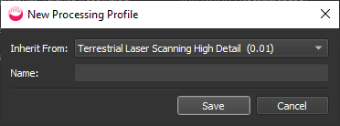Processing Profiles
A processing profile specifies the resolution and tolerances for converting point data to mesh models.
PointFuse has default profiles for the presumed level of detail for point clouds sourced from Terrestrial, Handheld, or Airborne technology, and for high, normal, and low quality of each.
The names of the default profiles are for guidance. The values best suited to converting your particular point data may differ. To compare them, crop to get a smaller portion of the point data (see Cropping Tool) and quickly do multiple conversions, using different profiles.
- Resolution:
The smaller the resolution value, the greater the detail, but the more time, memory and disk space may be used. There is no direct correlation between resolution and processing time: higher resolution models are sometimes quicker to generate than lower resolution ones. Typically in the range 0.005 – 1.5m. - Planar Fitting Tolerance:
The depth of field, typically one third of the resolution, in the range 0.001 to 0.3m. - Surface Angle Tolerance:
The threshold, in degrees, for creating an edge and new surface. Typically 22 degrees. If working with curved surfaces like pipes, try increasing to around 22 degrees. - Surface Area Tolerance:
The threshold, in meters squared, for creating a new surface. - Generate Textures
Select this if you want the mesh model to include textures (RGB or intensity) from the source point data. This is the only value you can change for default profiles. - Maximum Texture Resolution
If you opt to generate textures, you can select a lower maximum resolution for faster processing. - Generate Supertiles
If selected, a single model may comprise more than one mesh model file in the Project Explorer. Open them all in the same view to work with them as a single model. - Maximum Supertile Size
The threshold, in MB, at which data is split into supertiles.
For a list of values for each of the default processing profiles, see Preferences - Processing Profiles Tab.
Create Custom Processing Profiles
Custom profiles are not limited to the projects you created it for, but are available in all projects on your computer. You can view, create, and edit them from the Options menu and when creating a mesh model.
|
|
Options > Preferences |
Create Mesh Model |
|---|---|---|
|
1. |
Select the Options > Preferences dialog. Select the Processing Profiles tab. |
Click Make Mesh Model |
|
2. |
You see a dialog that includes a dropdown list of processing profiles. |
|
|
3. |
Select New. |
|
|
4. |
You see the New Processing Profile dialog:
|
|
|
5. |
Use the dropdown to select an existing profile to use as the basis for the new one. It can be one of those supplied with PointFuse, or a custom one you created previously. |
|
|
6. |
Type a Name and click Save. The previous tab or dialog is redisplayed. |
|
|
7. |
Amend fields by typing new values, using chevrons to increment or decrement, or checking/unchecking checkboxes. |
|
|
8. |
Choose whether this profile will Generate Textures by default. |
|
|
9. |
Click Apply to save changes and OK to close the dialog. |
Click OK to save changes, close the dialog and start generating surfaces. |
Delete Custom Processing Profiles
Delete custom processing profiles from the Preferences dialog. You cannot delete the default profiles.
Profiles relate to your computer, rather than the current project. Before deleting a profile, be certain you will not need it in another project.
- Select the Options > Preferences dialog, Processing Profiles tab.
- Use the dropdown to select an existing custom processing profile.
- Click Delete. You will not be prompted for confirmation and the profile will be deleted regardless of whether you then press OK, Cancel or Apply on the main Processing tab.
